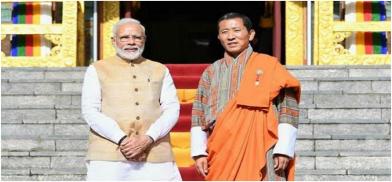India and Bhutan explore new areas of engagement
India understands the needs of Bhutan and is equally willing to diversify the relationship beyond hydropower. During his last visit, Modi showed India’s intent towards the diversification of bilateral relations, writes Alakh Ranjan for South Asia Monitor

Bhutan shares a deep and wide-ranging relationship with India. The two countries share a 699 sq km land boundary. Relations between the two neighbours are not only limited to geography, they also share commonalities in terms of Buddhist culture and spirituality. Hydropower has been an important pillar of the Indo-Bhutan relationship. The hydropower cooperation, which began in 1961 with the signing of the Jaldhaka agreement, has grown over the years as it has been mutually beneficial, providing clean electricity to India and generating considerable revenue for Bhutan. The ongoing cooperation in hydropower between India and Bhutan is governed by the 2006 agreement, under which the Government of India agreed to develop 10,000 MWs of hydroelectric power in Bhutan.
During his recent two-day visit to Bhutan, in August 2019, Indian Prime Minister Narendra Modi inaugurated the 720 MW Mangdechhu hydropower project, raising the current total hydropower capacity to around 2000 MW. India will play a decisive role in helping Bhutan to reach its optimum potential in this area. Bhutan, however, now wants to diversify its engagement with New Delhi beyond hydropower. India also wants to engage with Bhutan in the fields of tourism, education, space and technology.
Bhutan seeks to diversify its engagement because its economy is almost completely based on the hydropower sector, which makes its economic growth base very narrow. The hydropower sector also does not create many jobs and the issue of youth employment has gained significant prominence. Bhutan is relatively a young country; 60% of its population is below the age of 25 years. Bhutan’s Statistical Yearbook 2018 says although the overall unemployment rate in Bhutan has fallen from 2.9 % in 2013 to 2.1% in 2016, its youth unemployment rate has grown from 9.6% to 18.2% in the same period. The government wants to develop the manufacturing and service sector as these will help in creating more job opportunities for its youth.
Bhutan’s monarchy and Prime Minister Lotay Tshering’s government both understand the importance of education and technology and how they will aid in improving manufacturing and creating jobs for the youth. In several addresses to university students, King Jigme Namgyel Khesar Wangchuck has emphasised the need to focus on emerging technological advancements such as artificial intelligence, machine learning, big data and virtual reality, among others.
Bhutan is working towards making the country an industrial hub and it has improved in the Ease of Doing Business Index, from 148th in 2013 to 75th in 2017. Tourism contributes the second-highest share to the Gross Domestic Product (GDP) of Bhutan after hydropower. Revenue from the tourism sector is growing and the government sees this as a sector that can help in lowering youth unemployment. The tourism sector requires limited skills and can generate job opportunities for the youth.
India understands the needs of Bhutan and is equally willing to diversify the relationship beyond hydropower. During his last visit, Modi showed India’s intent towards the diversification of bilateral relations. Out of the 10 Memorandums of Understanding (MoUs) signed during his visit, seven were signed in the field of education and only one MoU was signed on hydropower. As India is aware that Bhutan is placing a lot of emphasis on its education sector, five Indian universities signed MoUs with different universities of Bhutan. Bhutanese students will now get access to India’s National Knowledge Network (NKN) which will connect them to various E-learning platforms. The signing of MoUs between the universities of both countries will connect the academicians and scholars and will give Bhutanese students a higher quality of education.
This century has been termed the ‘Knowledge Century,’ which will be driven by technology. India is advanced in various technologies such as space and Information Technology (IT). India has a large pool of IT professionals which can be a big help for the youth of Bhutan. In space technology, the Indian Space and Research Organisation (ISRO) is a pioneering institution. Signing of an MoU between ISRO and Bhutan’s Department of Information Technology and Telecom (DITT) and the agreement on the establishment of the SATCOM network for South Asia will help in boosting technological cooperation.
India has made the right moves towards the expansion of its relationship with Bhutan, which wants to move out of the list of the Least Developed Countries (LDCs). Bhutan is looking to reduce its dependence on foreign aid and be self-reliant. Technology and education can help Bhutan achieve these goals. India has ample resources in both these sectors to assist Bhutan and further strengthen this important relationship.
(The writer is an International Relations student at Jamia Milia Islamia University, New Delhi)








Post a Comment